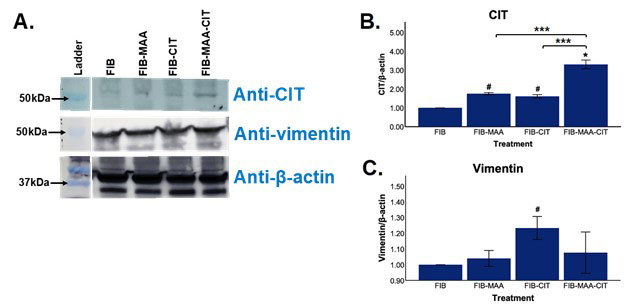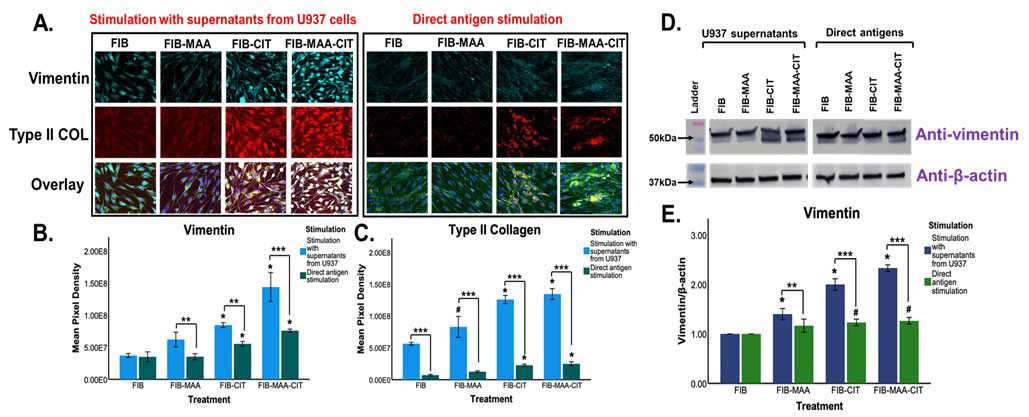Session Information
Session Type: Poster Session D
Session Time: 1:00PM-3:00PM
Background/Purpose: Studies have shown that activated macrophages secrete several factors that promote human fibroblast-like synoviocyte (HFLS) activation, resulting in an invasive phenotype, that contributes to extracellular matrix deposition and remodeling in the synovium of patients with rheumatoid arthritis (RA). We have previously shown that the modification of proteins with malondialdehyde-acetaldehyde (MAA) and/or citrulline are able to directly stimulate macrophages to initiate pro-inflammatory and profibrotic responses. However, it is unknown whether stimulated macrophages release factors that could affect HFLS function. Therefore, the purpose of this study was to evaluate whether MAA-modified and/or citrullinated fibrinogen is capable of stimulating macrophages to release factor(s) that activate HFLS and alter the deposition of extracellular matrix proteins.
Methods: Phorbol 12-myristate 13-acetate (PMA)-treated U937 cells were stimulated with MAA, citrulline (CIT), or MAA-citrulline (MAA-CIT) modified fibrinogen (FIB). U937 cell lysates were evaluated for citrullinated proteins, vimentin, and β-actin expression using Western Blot. HFLS from RA synovium (HFLS-RA) were incubated with U937 stimulated supernatants, or directly with the modified fibrinogen antigens. HFLS-RA cells were assessed for extracellular matrix deposition markers using fluorescent immunohistochemistry (IHC) and Western Blotting.
Results: Western Blots of U937 cells stimulated with FIB-MAA-CIT demonstrated increased citrullination (p< 0.001 vs. others) but no change in the expression of vimentin (57 kDa) (Fig. 1). Treatment of U937 cells with FIB-CIT led to a slight increase in both vimentin expression (p< 0.05) and citrullination of the same protein band (p< 0.05 vs. unmodified FIB). By IHC, exposure of HFLS-RA to U937 supernatants, collected following stimulation with FIB-CIT or FIB-MAA-CIT, demonstrated an elongated and round, “spindle-shaped” fibroblast morphology suggesting HFLS activation (Fig. 2A) and increased expression of vimentin (Fig. 2B, p< 0.001) and type II collagen (Fig. 2C, p< 0.001) as compared to direct HFLS stimulation. Similar results were observed by Western Blot wherein protein expression of vimentin was increased when HFLS-RA cells were incubated with U937 cell supernatants following stimulation with FIB-CIT (p< 0.001) or FIB-MAA-CIT (p< 0.001) in comparison to direct antigen stimulation (Fig.3D,E). In contrast, U937 supernatants from FIB-MAA treatment significantly increased HFLS-RA cellular deposition of type II collagen (p< 0.001) compared to direct stimulation with the same modification, but yielded less striking changes in cellular morphology (Fig. 3A,C).
Conclusion: These findings suggest that exposure to protein antigens modified with MAA and/or citrulline result in the release of citrullinated vimentin from macrophages. Furthermore, supernatants of activated macrophages induce HFLS secretion and deposition of extracellular matrices that likely contribute to the fibrotic responses observed in RA pathogenesis. Whether the HLFS activation observed is due to citrullinated vimentin, as has been demonstrated by other groups, warrants additional study.
To cite this abstract in AMA style:
Aripova n, Duryee M, Daubach E, hunter c, England B, O'Dell J, Mikuls T, Thiele G. Supernatants from Activated Macrophages Contain Citrullinated Vimentin and Induce Extracellular Matrix Deposition from Fibroblasts [abstract]. Arthritis Rheumatol. 2022; 74 (suppl 9). https://acrabstracts.org/abstract/supernatants-from-activated-macrophages-contain-citrullinated-vimentin-and-induce-extracellular-matrix-deposition-from-fibroblasts/. Accessed .« Back to ACR Convergence 2022
ACR Meeting Abstracts - https://acrabstracts.org/abstract/supernatants-from-activated-macrophages-contain-citrullinated-vimentin-and-induce-extracellular-matrix-deposition-from-fibroblasts/


